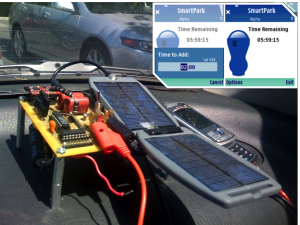Projects
Micropower Circuits and Systems Group
The Micropower Circuits and Systems Group directed by Prof. Rajeevan Amirtharajah focuses on aspects of energy-efficient electronic system design, including energy harvesting, voltage conversion, sensor interfaces, and sensor signal processing. Applications include food and beverage processing, mobile and wearable devices, and biomedical systems
Power Electronics
Power management integrated circuits are essential components for mobile devices such as phones, tablets, biomedical implants, and wearable electronics. A range of DC/DC and AC/DC conversion architectures with high efficiency are needed to provide stable power supplies for tomorrow’s integrated systems. Several projects in this area include wide output range low dropout (LDO) linear regulator design, low quiescent current inductor-based switching converter design, and efficient switched-capacitor converter design.

People: Sean Alling, Nathan Ellis
Related Publications:
- N. Ellis and R. Amirtharajah, “A Resonant Cockcroft-Walton Switched-Capacitor Converter Achieving Full ZCS and >10 kW/in.3 Power Density,” in 2019 IEEE Energy Conversion Congress and Expo (ECCE 2019), Sep. 2019, to appear.
- S. Nguyen, K. Yuk and R. Amirtharajah, “Pulse Skipping Modulation Method for Multiple Input Buck Boost Converter,” 2018 IEEE 19th Wireless and Microwave Technology Conference (WAMICON 2018), Sand Key, FL, 2018, pp. 1-4.
Support: Texas Instruments
RF Energy Harvesting
Wearable form factors offer an exciting opportunity for harvesting radio frequency energy because the antenna can be sized proportionally to the wavelength for efficient power transfer. We are exploring how best to incorporate antennas and coils for far- and near-field energy harvesting in smart jewelry such as necklaces and rings.

People: Son Nguyen, Sean Alling, Connie Duong
Related Publications:
- S. Nguyen, K. Yuk, R. Amirtharajah and G. R. Branner, “Radiation Patterns of an RF Energy Harvesting Necklace on Human Body Phantom,” 2018 IEEE International Symposium on Antennas and Propagation & USNC/URSI National Radio Science Meeting, Boston, MA, 2018, pp. 2551-2552.
- S. Nguyen and R. Amirtharajah, “A Hybrid RF and Vibration Energy Harvester for Wearable Devices,” 2018 IEEE Applied Power Electronics Conference and Exposition (APEC 2018), San Antonio, TX, 2018, pp. 1060-1064.
- S. Nguyen, N. Ellis, and R. Amirtharajah, “Powering Smart Jewelry Using an RF Energy Harvesting Necklace,” 2016 IEEE MTT-S International Microwave Symposium (IMS 2016), San Francisco, CA, 2016, pp. 1-4.
Support: Google
Integrated Photovoltaics and Betavoltaics
Reducing the size and cost of wireless sensors and medical implants is essential to realize the promise of body-area networks and ambient
intelligence. By integrating photovoltaic cells on-chip in conventional CMOS processes and betavoltaic cells in SOI CMOS, we hope to achieve these reductions while minimizing the overall complexity of the device. On-chip photovoltaics produce low voltages, typically on the order of a few hundred millivolts for most light intensities, thus requiring subthreshold circuit design and extensive digital correction of sensitive analog blocks. However, we can exploit the extensive metal layers in modern VLSI processes to create light guiding structures that can improve the efficiency of on-die photovoltaics.

People: Heather Richardson
Related Publications:
- E. Fong, N. Guilar, T. Kleeburg, H. Pham, D. Yankelevich, and R. Amirtharajah, “Integrated Energy-Harvesting Photodiodes With Diffractive Storage Capacitance,” IEEE Transactions on VLSI Systems, Vol. 21, No. 3, March 2013, pp. 486-97.
- N. Guilar, A. Chen, T. Kleeburg, D. Yankelevich, and R. Amirtharajah, “Integrated Solar Energy
Harvesting and Storage,” IEEE Transactions on VLSI Systems, Vol. 17, No. 5, May 2009, pp. 627-37.
Support: Texas Instruments, DMEA
Sensors for Winemaking and Viticulture

In collaboration with faculty in the department of Viticulture and Enology, the UC Davis Robert Mondavi Institute for Food and Wine Science, and the support of industry, we are developing inline sensors for monitoring wine fermentation.

People: Tim Ambrose, Ken Thomas, C. Brenneman, Prof. V. Akella, Prof. A. Knoesen, Prof. R. Boulton, Prof. D. Block, Prof. D. Mills, Dr. K. Boundy-Mills, Dr. J. Brigham
Related Publications:
- N. Shrake, R. Amirtharajah, C. Brenneman, R. Boulton, and A. Knoesen. “In-line Measurement of Color and Total Phenolics During Red Wine Fermentations Using a Light-Emitting Diode Sensor,” American Journal of Enology and Viticulture, 65(4): 463-470.
Support: Rodgers University Fellowship, Cypress Semiconductor, Sloan Foundation, Agilent
Indoor Photovoltaic Energy Harvesting
Many commercially-available solar cells are optimized for the spectrum of sunlight. Indoor light intensity is orders of magnitude lower than bright outdoor sunlight, making the low power design of indoor photovoltaic energy harvesting systems essential. Furthermore, energy-efficient lighting sources such as fluorescent lights and LEDs have significant flicker associated with the AC mains frequency and pulse-width modulated dimming, respectively. This project seeks to understand the impact of these characteristics on photovoltaic energy harvesting systems and how they can be mitigated through power electronics circuit design.
People: Sean Alling, Andrew Chang
Related Publications:
- S. Hsu, E. Fong, V. Jain, T. Kleeburg, and R. Amirtharajah, “Switched-Capacitor Boost Converter Design and Modeling for Indoor Optical Energy Harvesting with Integrated Photodiodes,” ACM/IEEE 2013 International Symposium on Low Power Electronics and Design (ISLPED 2013), September 2013, pp. 169-74.
Support: Texas Instruments, Bosch
Low Power Embedded Systems
A major challenge in developing software for energy-constrained devices such as mobile phones is addressing the heterogeneity of hardware and operating systems, changing device environment, and diverse user workloads that compete for the same energy resource. The migration of computationally-demanding machine learning algorithms to embedded systems such as robots presents further challenges to managing power consumption.
People: Tim Ambrose, Prof. V. Akella
Related Publications:
- F. Maker, R. Amirtharajah, and V. Akella, “Runtime Adaptation of Applications Using Design of Experiments: A Smartphone-Based Case Study,” IEEE Embedded Systems Letters, Vol. 6, Number 2, June 2014, pp. 25-8.
- F. Maker, R. Amirtharajah, and V. Akella, “MELOADES: Methodology for Long-Term Online Adaptation Embedded Software for Heterogeneous Devices,” Journal of Systems Architecture, Vol. 59, Issue 8, September 2013, pp. 643-55.
Sustainable Electronics
The dark side of today’s revolution in mobile devices is the vast quantity of electronic waste (e-waste) generated by the world’s insatiable demand for the latest mobile phones. Under some circumstances, more energy is expended in fabricating the semiconductors in a smartphone than is used to power those same chips over the typical (short) operating life of the phone. We launched a project to determine if it made sense from a sustainability perspective to design phones (and other embedded systems) for reuse in other applications, as an alternative to recycling the phone for its raw materials upon its retirement from use as a phone. In collaboration with industrial ecologists at UC Santa Barbara, we have recently shown that reuse decreases negative impacts to the environment and human health, but many tradeoffs are involved – even where the reused phone is plugged in to recharge makes a significant impact.

People: Tim Ambrose, Prof. V. Akella, Prof. R. GeyerThe first sensors included an LED-based multispectral colorimeter for measuring the development of color and phenolics in real time and a dielectric impedance spectroscopy systems for measuring the yeast growth curve and higher alcohols in distillations. In addition to these sensors, we are also developing wireless sensor systems for measuring indoor environmental conditions to help track growth of building microbes, an actuator system for precise control of vineyard irrigation, and exploring hyperspectral imaging to track vine growth.
Multimedia:
Related Publications:
- T. Zink, F. Maker, R. Geyer, R. Amirtharajah, and V. Akella, “Comparative Life Cycle Assessment of Smartphone Reuse: Repurposing vs. Refurbishment,” International Journal of Life Cycle Assessment, Vol. 19, Number 5, May 2014, pp. 1099-1109.
- J. Oliver, R. Amirtharajah, V. Akella, R. Geyer, and F. Chong,“Life Cycle Aware Computing: Reusing Silicon Technology,” IEEE Computer, Vol. 40, No. 12, Dec. 2007, pp. 56-61.
Support: Nokia
Mechanical Vibration Energy Harvesting
Many wireless sensor nodes are deployed in places that have significant mechanical energy, for example on rotating machinery, vibrating structures like bridges and staircases, or worn on the body. The rapid reduction in power consumption of electronics has made harvesting this mechanical energy for powering circuits a practical reality in the last two decades. Over the course of several projects, we have explored the design and optimization of electromagnetic, piezoelectric, and MEMS transducers for converting this mechanical energy to usable electricity. Co-designing the power electronics needed to convert the raw output of the transducer into supply voltages suitable for analog and digital load circuits remains challenging, especially if efficiency must be high or the transducer needs to be biased at its maximum power point.

People: Son Nguyen, Andrew Chang
Related Publications:
- S. Nguyen and R. Amirtharajah, “A Hybrid RF and Vibration Energy Harvester for Wearable Devices,” 2018 IEEE Applied Power Electronics Conference and Exposition (APEC 2018), San Antonio, TX, 2018, pp. 1060-1064.
- N. Guilar, R. Amirtharajah and P. Hurst, “A Full-Wave Rectifier With Integrated Peak Selection for Multiple Electrode Piezoelectric Energy Harvesters,” IEEE Journal of Solid-State Circuits, Vol. 44, No. 1, Jan. 2009, pp. 240-6.
Support: Bosch
Computer Architecture
Many emerging technologies have the potential to disrupt today’s dominant computer architectures. In collaboration with faculty from Computer Science, we are working to understand how photonic interconnects, wide bandgap semiconductors, subthreshold CMOS, and thermoelectric cooling will change future multicore microprocessors and memory systems.
People: Prof. M. Farrens, Prof. V. Akella, Prof. S.-J. B. Yoo
Related Publications:
- H. Zhang, R. Amirtharajah, C. Nitta, M. Farrens, and V. Akella, “Burst Mode Processing: An Architectural Framework for Improving Performance in Future Chip Multiprocessors,” ACM Workshop on Managing Overprovisioned Systems (W-MOS 2014) at 19th International Conference on Architectural Support for Programming Languages and Operating Systems (ASPLOS 2014), 1 March 2014.
- L. Zhou, S. Djordjevic, R. Proietti, D. Ding, S. Yoo, R. Amirtharajah, and V. Akella, “Design and Evaluation of an Arbitration-Free Passive Optical Crossbar for On-Chip Interconnection Networks,” Applied Physics A, Vol. 95, No. 4, June 2009, pp. 1111-8.
- A. Hadke, T. Benavides, R. Amirtharajah, M. Farrens, and V. Akella, “Design and Evaluation of an Optical CPU-DRAM Interconnect,” 2008 IEEE Int’l. Conference on Computer Design (ICCD 08), 12-5 Oct. 2008, pp. 492-7.
- A. Hadke, T. Benavides, S. Yoo, R. Amirtharajah, and V. Akella, “OCDIMM: Scaling the DRAM Memory Wall Using WDM Based Optical Interconnects,” 16th IEEE Symposium on High Performance Interconnects (HOTI 08), 26-8 Aug. 2008, pp. 57-63.
